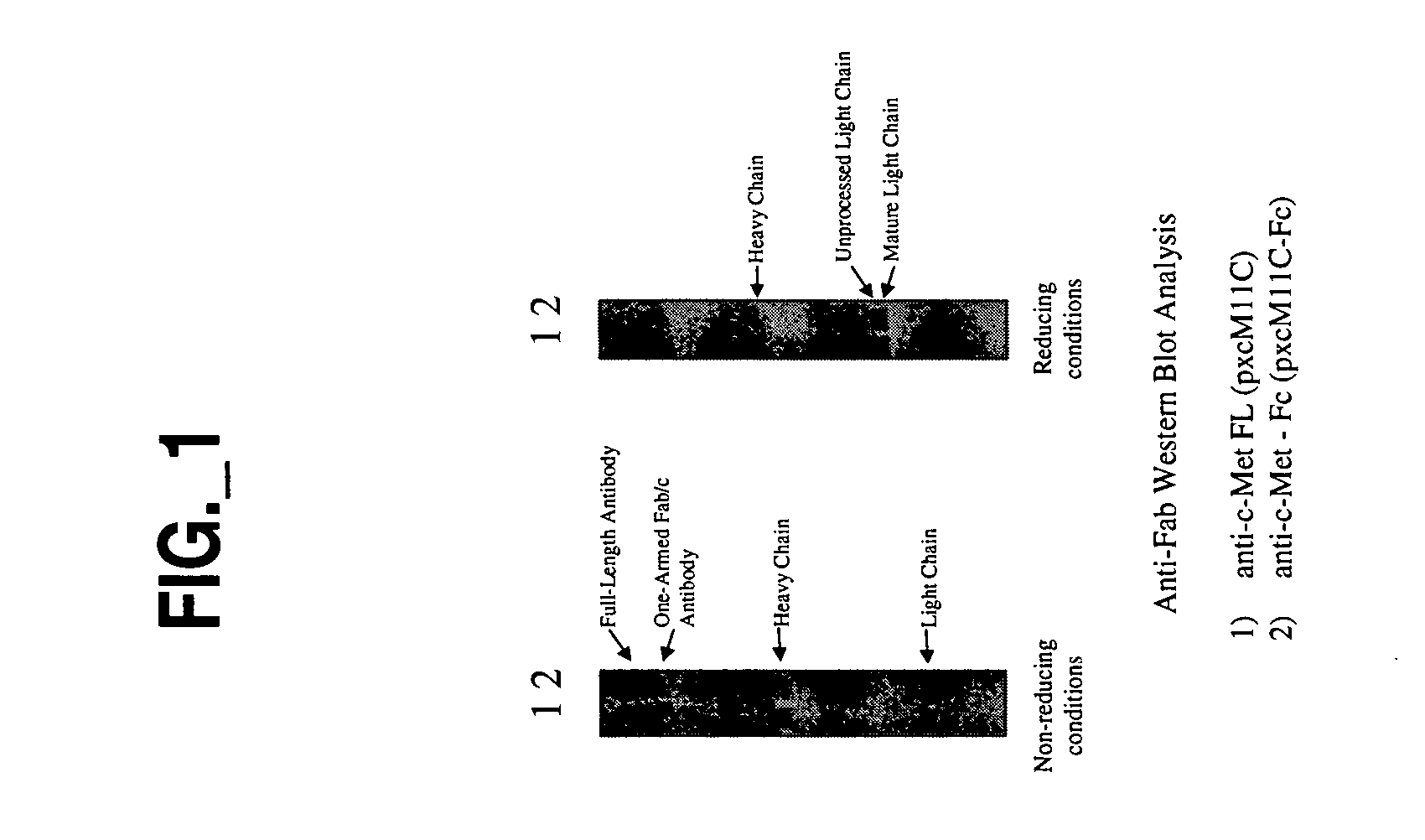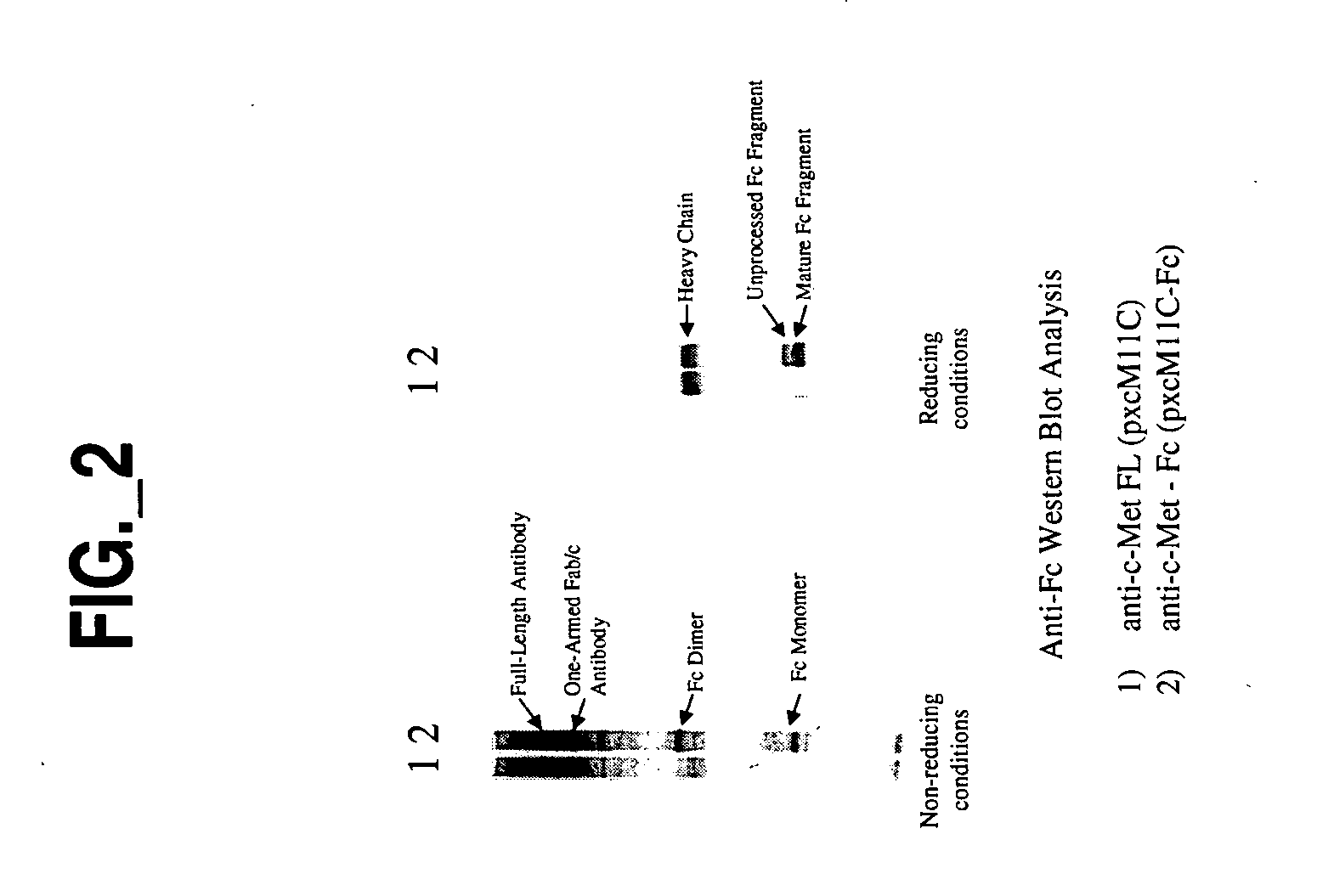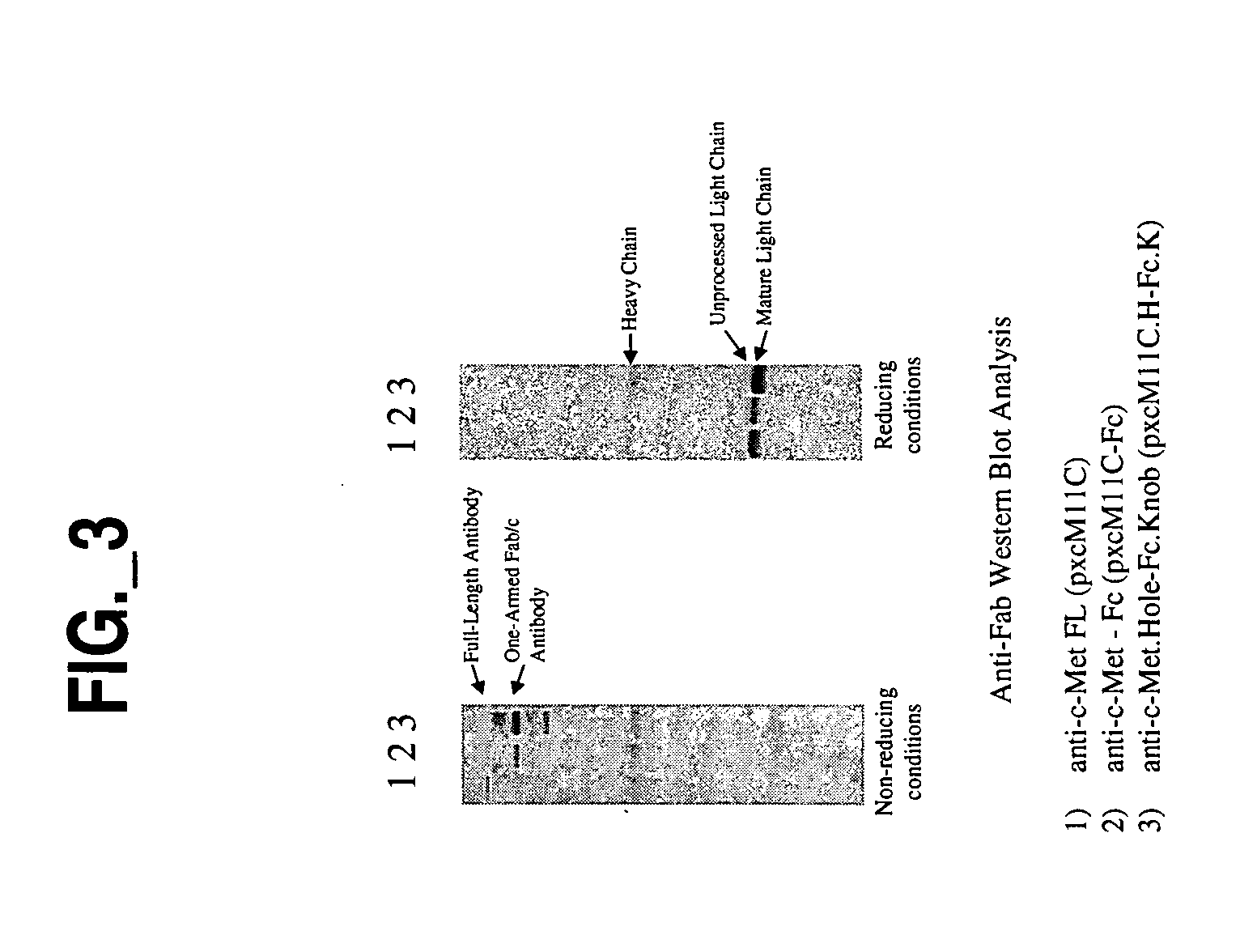[0010] The invention provides a form of antibody that provides various advantages with respect to therapeutic utility, functionality and
methods of production thereof. In one aspect, an antibody of the invention provides a monovalent characteristic which is essential for certain non-immune response based therapeutic schemes. For example, in
pathological conditions requiring an antagonistic function, and where bivalency of an antibody results in an undesirable agonistic effect, the monovalent trait of an antibody of the invention results in and / or ensures an antagonistic function upon binding of the antibody to a target molecule. Furthermore, an antibody of the invention is characterized by superior pharmacokinetic attributes (such as an enhanced
half life and / or reduced
clearance rate in vivo) compared to Fab forms having similar / substantially identical
antigen binding characteristics, thus overcoming a major drawback in the use of conventional monovalent Fab antibodies. In one aspect, an antibody of the invention comprises little to no
immune effector functions, a trait which is particularly useful in treating
pathological conditions wherein an
immune effector response is deleterious. In another aspect, an antibody of the invention is characterized by alterations that greatly improve production yield. Furthermore, as opposed to certain conventional methods for producing monovalent
antibody fragments (e.g.,
enzymic digestion, followed in some instances by chemical couplings), the recombinant nature of the production methods of the invention makes it possible to obtain antibody populations that are of a sufficiently high degree of homogeneity and / or purity useful for development and / or commercialization as therapeutic agents.
[0011] Accordingly, in one aspect, the invention provides a monovalent antibody fragment comprising a single target molecule binding arm and an Fc region (i.e., a complex of Fc polypeptides), wherein the monovalent antibody fragment is more stable
in vivo than a counterpart antibody fragment lacking said Fc region. In one aspect, the invention provides an antibody fragment comprising a single
antigen binding arm and an Fc region that increases stability of the antibody fragment (i.e., it is more stable, e.g. it exhibits a longer
in vivo half life) compared to a Fab molecule comprising said
antigen binding arm, wherein said Fc region comprises a complex of a first and a second Fc polypeptide, wherein one but not both of the Fc polypeptides is an N-terminally truncated
heavy chain. In one embodiment, an N-terminally truncated
heavy chain consists or consists essentially of a hinge sequence continguously linked to at least a portion of a
heavy chain CH2 and / or CH3 domain sufficient to form a complex with the first Fc polypeptide and confer said increased stability. In one embodiment, an N-terminally truncated heavy chain consists or consists essentially of a hinge sequence continguously linked to a heavy chain CH2 and / or CH3 domain capable of forming a complex with the first Fc polypeptide and conferring said increased stability. In one embodiment, the N terminal sequence of the N-terminally truncated heavy chain is part or all of a hinge sequence (i.e., the truncated heavy chain comprises an
N terminus which comprises or is part or all of a hinge sequence). In one embodiment, the N-terminally truncated heavy chain is of an IgG heavy chain. In one embodiment, the Fc region is capable of binding to FcRn. In one embodiment, the Fc region does not possess an
immune effector function other than binding to FcRn. Generally and preferably, the N-terminally truncated heavy chain does not specifically bind an antigen.
[0020] In one aspect, the invention provides an antibody fragment comprising at least one characteristic that promotes heterodimerization, while minimizing homodimerization, of the Fc sequences within the antibody fragment. Such characteristic(s) improves yield and / or purity and / or homogeneity of the immunoglobulin populations obtainable by methods of the invention as described herein. In one embodiment, a first Fc polypeptide and a second Fc polypeptide meet / interact at an interface. In some embodiments wherein the first and second Fc polypeptides meet at an interface, the interface of the second Fc polypeptide (sequence) comprises a protuberance which is positionable in a cavity in the interface of the first Fc polypeptide (sequence). In one embodiment, the first Fc polypeptide has been altered from a template / original polypeptide to
encode the cavity or the second Fc polypeptide has been altered from a template / original polypeptide to
encode the protuberance, or both. In one embodiment, the first Fc polypeptide has been altered from a template / original polypeptide to
encode the cavity and the second Fc polypeptide has been altered from a template / original polypeptide to encode the protuberance. In one embodiment, the interface of the second Fc polypeptide comprises a protuberance which is positionable in a cavity in the interface of the first Fc polypeptide, wherein the cavity or protuberance, or both, have been introduced into the interface of the first and second Fc polypeptides, respectively. In some embodiments wherein the first and second Fc polypeptides meet at an interface, the interface of the first Fc polypeptide (sequence) comprises a protuberance which is positionable in a cavity in the interface of the second Fc polypeptide (sequence). In one embodiment, the second Fc polypeptide has been altered from a template / original polypeptide to encode the cavity or the first Fc polypeptide has been altered from a template / original polypeptide to encode the protuberance, or both. In one embodiment, the second Fc polypeptide has been altered from a template / original polypeptide to encode the cavity and the first Fc polypeptide has been altered from a template / original polypeptide to encode the protuberance. In one embodiment, the interface of the first Fc polypeptide comprises a protuberance which is positionable in a cavity in the interface of the second Fc polypeptide, wherein the protuberance or cavity, or both, have been introduced into the interface of the first and second Fc polypeptides, respectively.
[0036] An antibody of the invention is suitable for treating or preventing any of a number of
pathological conditions resulting from any of a number of cellular, genetic and / or biochemical abnormalities. For example, an antibody of the invention is particularly suitable for treating and / or preventing pathological conditions associated with abnormalities within the HGF / c-met signaling pathway. In one embodiment, an antibody of the invention is a c-met
antagonist. In one embodiment, the antibody is a
chimeric antibody, for example, an antibody comprising
antigen binding sequences from a non-human donor grafted to a
heterologous non-human, human or humanized sequence (e.g., framework and / or
constant domain sequences). In one embodiment, the non-human donor is a mouse. In one embodiment, an
antigen binding sequence is synthetic, e.g. obtained by
mutagenesis (e.g.,
phage display screening, etc.). In one embodiment, a
chimeric antibody of the invention has murine V regions and human
C region. In one embodiment, the murine light chain
V region is fused to a human kappa light chain. In one embodiment, the murine heavy chain
V region is fused to a human IgG1
C region. In one embodiment, the
antigen binding sequences comprise at least one, at least two or all three CDRs of a light and / or heavy chain. In one embodiment, the antigen binding sequences comprise a heavy chain CDR3. In one embodiment, the antigen binding sequences comprise part or all of the CDR and / or
variable domain sequences of the
monoclonal antibody produced by the
hybridoma cell line deposited under American Type Culture Collection Accession Number ATCC HB-11894 (hybridoma 1A3.3.13) or HB-11895 (hybridoma 5D5.11.6). In one embodiment, the antigen binding sequences comprise at least CDR3 of the heavy chain of the
monoclonal antibody produced by the
hybridoma cell line 1A3.3.13 or 5D5.11.6. Humanized antibodies of the invention include those that have
amino acid substitutions in the FR and
affinity maturation variants with changes in the grafted CDRs. The substituted amino acids in the CDR or FR are not limited to those present in the donor or recipient antibody. In other embodiments, the antibodies of the invention further comprise changes in
amino acid residues in the Fc region that lead to improved
effector function including enhanced CDC and / or ADCC function and B-
cell killing. Other antibodies of the invention include those having specific changes that improve stability. Antibodies of the invention also include
fucose deficient variants having improved ADCC function in vivo.
[0051] In one aspect, the invention provides a method for treating or preventing a
cell proliferative disorder associated with increased expression or activity of c-met or
hepatocyte growth, or both, said method comprising administering to a subject in need of such treatment an effective amount of a c-met
antagonist antibody fragment of the invention, thereby effectively treating or preventing said
cell proliferative disorder. In one embodiment, said proliferative disorder is
cancer.
[0053] In one aspect, the invention provides a method of therapeutically treating a tumor in a
mammal, wherein the growth of said tumor is at least in part dependent upon a growth potentiating effect of c-met or
hepatocyte growth factor, or both, said method comprising contacting said cell with an effective amount of a c-met
antagonist antibody fragment of the invention, thereby effectively treating said tumor. In one embodiment, the cell is contacted by HGF expressed by a different cell (e.g., through a paracrine effect).
 Login to View More
Login to View More 


